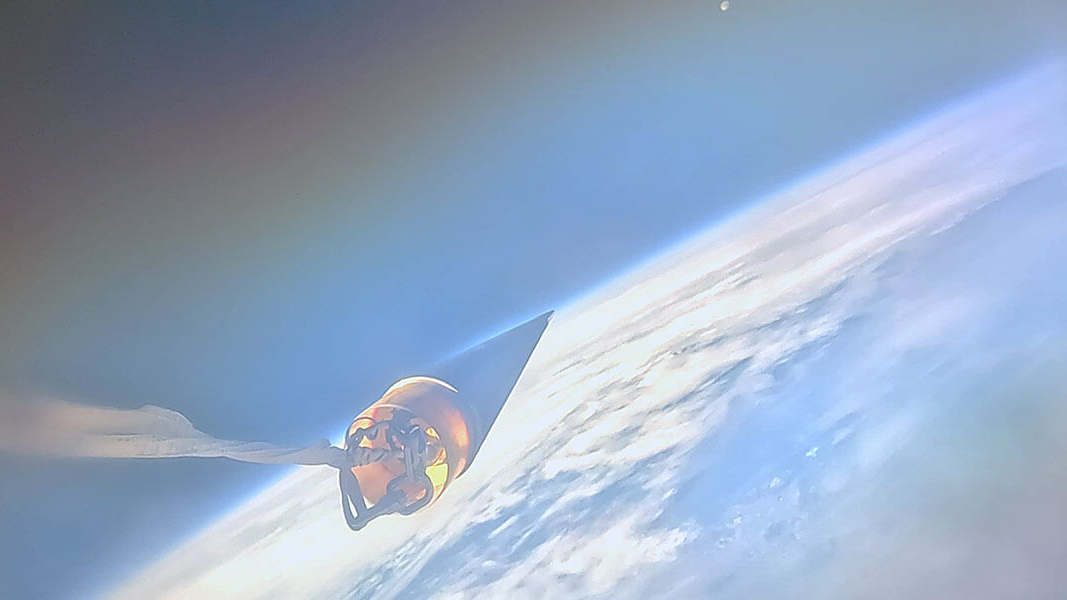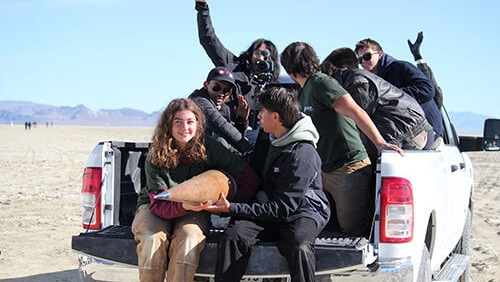The University of Southern California's student rocketeers have done it again.
The USC Rocket Propulsion Lab (USCRPL) — which in 2019 became the first student organization ever to launch a rocket to space — sent its Aftershock II vehicle 470,400 feet (89.09 miles, or 143.38 kilometers) above Earth last month. That smashed the amateur altitude record of 380,000 feet (71.97 miles, or 115.82 km), which was set in 2004 by the Civilian Space Exploration Team.
"This achievement represents several engineering firsts," Ryan Kraemer, the executive engineer of USCRPL and an undergrad majoring in mechanical engineering, said in a statement on Friday (Nov. 15). "Aftershock II is distinguished by the most powerful solid-propellant motor ever fired by students and the most powerful composite case motor made by amateurs."

USCRPL's groundbreaking April 2019 liftoff, from New Mexico's Spaceport America, involved a rocket called Traveler IV. (Traveler is also the name of the horse ridden by USC's Trojan mascot.) That vehicle reached a maximum altitude of 339,800 feet (64.4 miles, or 103.6 km) — above the 62-mile-high (100 km) Kármán Line, which many people view as the boundary of space — and a top speed of 3,386 mph (5,449 kph).
Related: USC students' rocket reaches space in record-setting launch
Aftershock II's landmark launch took place on Oct. 20 from the Black Rock Desert in Nevada. The 13-foot-tall (4 m), 330-pound (150 kilograms) rocket flew higher and faster than its predecessor, reaching a max speed of 3,602 mph (5,797 kph).
"This result establishes Aftershock II as the fastest and highest amateur rocket of all time," the team wrote in a white paper verifying the flight data, which was posted on Thursday (Nov. 14).
Get the Space.com Newsletter
Breaking space news, the latest updates on rocket launches, skywatching events and more!
The student team made this leap thanks to a new avionics unit and other important upgrades.
"To exceed the standard we set for ourselves with Traveler IV, we had to solve many technical and operational challenges," Kraemer said.
"Thermal protection at hypersonic speeds is a major challenge at the industry level, and the protective paint system that we developed performed perfectly, enabling the rocket to return largely intact," he added. "We also made an important upgrade to the fins, replacing the bare carbon edge of previous iterations with titanium leading edges. The titanium not only prevented fraying but actually turned blue from the intense heat during flight through anodization, which really demonstrates the extreme conditions our rocket successfully endured."

Aftershock II also featured custom computer systems and circuit boards, which the students designed and built from scratch, according to the Nov. 15 statement.
"This is an exceptionally ambitious project not only for a student team, but for any non-professional group of rocket engineers," Dan Erwin, chair of the USC Department of Astronautical Engineering, said in the statement. "It’s a testament to the excellence we seek to develop in our emerging astronautical engineers, who go on to achieve top roles in the space industry and in government positions."
Editor's note: This story was corrected at 4:50 p.m. ET on Nov. 18 to state that the Aftershock II launch occurred on Oct. 20, not Oct. 24.
Join our Space Forums to keep talking space on the latest missions, night sky and more! And if you have a news tip, correction or comment, let us know at: community@space.com.

Michael Wall is a Senior Space Writer with Space.com and joined the team in 2010. He primarily covers exoplanets, spaceflight and military space, but has been known to dabble in the space art beat. His book about the search for alien life, "Out There," was published on Nov. 13, 2018. Before becoming a science writer, Michael worked as a herpetologist and wildlife biologist. He has a Ph.D. in evolutionary biology from the University of Sydney, Australia, a bachelor's degree from the University of Arizona, and a graduate certificate in science writing from the University of California, Santa Cruz. To find out what his latest project is, you can follow Michael on Twitter.
-
Thermoman Reply
That is good engineering etc but to what point of usefullness is that ? Why do people think they are going to conquer space with a Rocket when they quite clearly are not because of physics ?Admin said:The student-run USC Rocket Propulsion Lab's Aftershock II vehicle soared to an altitude of 470,400 feet last month, higher than any amateur rocket had ever gone before.
USC students set world record with high-flying rocket launch (video) : Read more
I have many ways of beating space and testing long range missiles isn't one of them ! -
COLGeek Reply
Many claims and unconventional theories, you have. Share them, you will?Thermoman said:That is good engineering etc but to what point of usefullness is that ? Why do people think they are going to conquer space with a Rocket when they quite clearly are not because of physics ?
I have many ways of beating space and testing long range missiles isn't one of them !
Sorry, in a Yoda mood this morning. -
Mikeshbike They are applying what they learn in class. That is the value. They are part of the next generation of aerospace engineersReply

